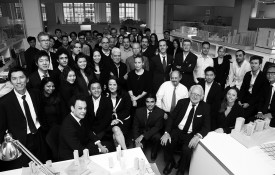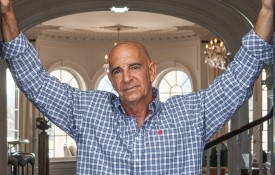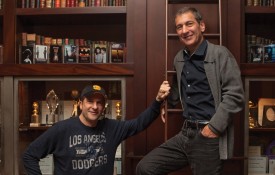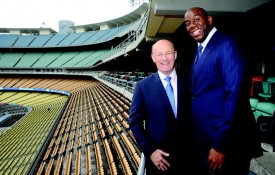“Effective philanthropy requires time and creativity – the same kind of focus and skills that building a business requires.”
Though spoken by Bill Gates, these words could easily apply to Marc and Jane Nathanson. So closely linked are the Nathansons’ work careers with their charitable endeavors, it can be difficult to pinpoint where one ends and the other begins.
Marc, currently Chairman of Mapleton Investments and Falcon Waterfree Technologies, originally found success in the cable industry, which provided the genesis for his work on international communications and environmental issues. Jane’s interest in fine art and psychology led to her involvement as a trustee at the Los Angeles County Museum of Art and the endowment of the Nathanson Family Resilience Center at UCLA.
The Nathansons decided early on that their philanthropic efforts would serve to complement their various interests, and they would support each other rather than duplicate efforts—a lifestyle that is reflected in their museum-like residence in Holmby Hills. Bright afternoon rays spill into the high-ceilinged room as Jane points out the couple’s favorite piece: an Andy Warhol Double Elvis painting that stands nearly seven feet tall.
“In the past 10 years, LACMA has totally changed the dynamic of where people look internationally for new art.”
“I remember when they couldn’t give Warhols away,” Jane recalls with bemusement. “It has always been our belief that we are very lucky to live with the art that we live with.” The Nathansons’ impressive collection of quirky contemporary art is tastefully displayed throughout their living environment: on walls, in otherwise vacant corners, and outdoors. “But,” she says, “we believe that all great art should eventually go to institutions so that everybody can enjoy it.”
That attitude of giving back inspired the Nathansons to pledge $50mm worth of art to LACMA this year to commemorate the institution’s 50th anniversary celebration. While an enormously generous gift in itself, the bequeathal represents only a small part of the pair’s involvement with the LA art scene.
Originally from New York, Jane was surprised to discover that, when she and Marc first arrived in LA in the 1970s, there was no contemporary art museum already established. She, along with others such as Mayor Tom Bradley, Eli Broad, and Marcia Weisman, combined forces and founded the Museum of Contemporary Art (MOCA), on Bunker Hill downtown. She has presided on boards for other museums and has been a member of LACMA’s board since 2005. She firmly believes the West Coast is on a par with the great museum regions of the world.
“In the past 10 years, LACMA has totally changed the dynamic of where people look internationally for new art,” she says. “New York is following us now, along with Europe and China. To me, this is the most exciting place you can be as far as the art world goes.”
East Coast Roots
Raised by parents who were European art collectors, Jane cites her father Fred Fallek as a mentor who taught her to look at art, to give back, and to help the underdog. “He was an inspirational character to me. He came over during the war in Germany and started all over again and built a really successful career. He’s somebody I wanted to emulate and make proud.”
Originally an art major with a degree from the University of Denver, Jane has developed a well-trained eye for superlative pieces. The secret, she says, is simply to keep looking at museums and galleries. “I compare it to eating pizza—it’s all the same ingredients but some are really good and some are just not good. If you’ve eaten enough pizza, you know the difference.” Usually, she and her husband pick out art for their collection together, but Marc readily defers to Jane’s expertise. “For my 35th birthday, Jane bought me a painting for our collection from an unknown artist at his first show for the value of about $2,000, and he turned out to be a very important, major artist. That’s an example of what a good eye and good taste she has,” Marc says.
Marc came from a very different background. His father was in advertising and broadcasting, and his grandfather was a movie distributor. Born in Los Angeles but raised in Chicago, he got his start selling cable door to door, then worked in an advertising agency in Denver. Marc met Jane in a freshman year speech class at the University of Denver where he was studying political science. He went on to earn his masters in political science at UC Santa Barbara, writing his thesis on the regulation of cable television.

Among the works that populate the walls of the Nathansons’ museum-like home are pieces by Liechtenstein and Barbara Kruger (Photos: Zach Lipp)
The Cable Guy
Cable, it turned out, would make Marc a millionaire. After working for TelePrompTer—where he signed the first contract for HBO—and stints at Warner Cable and Cypress Communications Corporation, he would go on to start his own company, Falcon Cable TV, in 1975. To him, it was a natural evolution of the skills he’d learned when he was building cable systems in Bakersfield and Kern County. Customers there had only three network stations and didn’t see a need for cable – until Marc pointed out that they would now have access to educational television and independent stations from LA. Within a year, 50 percent of that customer base had subscribed.
“It’s about understanding what the public wants and being able to provide it. When I started, 5 percent of Americans subscribed to cable TV. When I sold my company in 1999, that number was closer to 70 percent.”
The idea of bringing services to outsiders has extended to Marc’s philanthropic and political endeavors as well. In 1995 President Clinton appointed him to head the Broadcasting Board of Governors (BBG), an independent federal agency designed to supervise all U.S. government backed, non-military international broadcasting. There, his role was to bring news, information, and Internet to nations constrained by digital isolation and political censorship, with the ultimate goal of promoting freedom and democracy.
“The world has an insatiable appetite for news and information and they want to choose what they want to watch,” Marc says. Though no longer with the BBG, he continues as vice chairman of the National Democratic Institute of International affairs (NDI), is a board member of the Pacific Council, and is a board member of the Aspen Institute, a policy-studies organization.
Marc sold Falcon Cable in 1999 for $3.7B and has since focused his energy on managing investments, particularly in real estate, through the Nathanson’s company Mapleton Investments. Through Mapleton, they have invested in venture capital, including Falcon Waterfree Technologies. Water conservation and protecting the environment are important issues to the Nathansons, and not just on a local level. “We’re in over 50 different countries,” he points out. “There are droughts all over the world at different times, but the bottom line is that it makes no sense to waste drinkable, fresh water.” Falcon Waterfree focuses on urinals, drains, and other washroom products, mostly designed for commercial buildings like schools, offices, stadiums, and hospitals.

The gallery on the ground floor of the Nathanson residence features unique pieces like Duane Hanson’s “Old Couple on the Bench” and Zhang Huan’s “Family Tree”
A Greater Good
The presence of the Nathansons can also be seen at Cedars-Sinai, where they have built a meditation room on every floor and have sponsored private rooms for counseling sessions between doctors and patients. They also have a clinic at UCLA called the Nathanson Family Resilience Center, which assists foster care participants, veterans returning from Iraq, and families with patients in the Neuroscience Psychiatric Institute (NPI).
This sensitivity to emotional needs stems not just from a desire to help others, but from Jane’s personal interest in mental health and psychology. A close friend of theirs developed AIDS in the early 1980s, and she was dismayed to discover there was no mental health available to serve him.
“There are droughts all over the world at different times, but the bottom line is that it makes no sense to waste drinkable fresh water.”
“I couldn’t get anybody to see him,” she tells us, “so I formed a group in my living room. I quickly realized I was way out of my element – I was in my 20s and all these young people were dying within a year of diagnosis, and I had no idea what I was doing.” Jane had been working as a real estate broker, but the experience inspired her to return to school and become a licensed psychologist and marriage and family therapist. She has since moved on from AIDS activism, mostly because the disease is much better understood and treated now than it was then. But she continues to run her own private practice.
“We should all be working together for the greater good,” she tells us, to which Marc adds, “It’s important to share, however you can.” That attitude, toward business, philanthropy, and art, is evident in every aspect of the Nathansons’ life. If there’s one message they would love to share with people, especially with regard to art, it’s that people should not think in terms of owning something forever. “Think in terms of enjoying it and living with it, and then allowing the public to enjoy and live with it. Too many people today are building their own museums, and their collection becomes a housing for their ego,” Jane observes. “I really think art teaches so many things that it should be in public institutions like LACMA or any of the public museums where everybody can come and take a walk through history. It’s a universal language, one of the most powerful universal languages we have.”














































